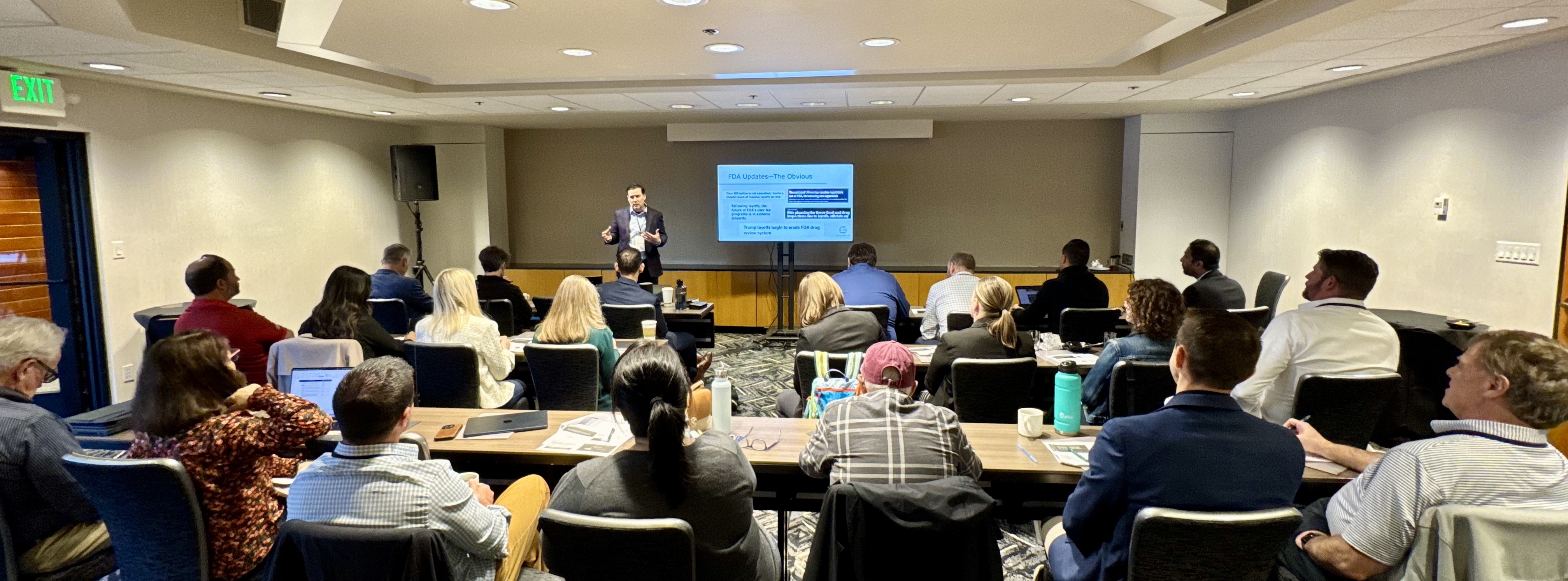Event Recap: Ski-LE – An In Person FDA and Compliance Legal - Regulatory Update
April 22, 2025A high-altitude summit of FDA and compliance minds
On April 11, 2025, professionals across medtech, laboratory, and biotech sectors convened at Utah’s Snowbird Resort for Ski-LE, Gardner Law’s annual in-person legal and regulatory update. Against the backdrop of the Wasatch Mountains, attendees engaged in four hours of accredited CLE and RAPS-recognized programming on the most urgent compliance, litigation, and FDA developments shaping the regulatory landscape.
The program was co-chaired by Mark Gardner and Mike Pisetsky and featured expert guidance from:
- Mark Gardner, Founder and Managing Partner, Gardner Law
- Mike Pisetsky, Chief Business & Legal Affairs Officer, SI-BONE
- Nathan Downing, Managing Attorney, Gardner Law

Program Highlights:
Mark Gardner kicked off Ski-LE with a wide-angle lens on the current state of U.S. healthcare regulation, beginning with the latest and most disruptive development: recent mass layoffs at the FDA. These include the release of over 220 staff within CDRH—a change that could impact review timelines, reduce approval predictability, and limit industry’s ability to engage constructively with regulators. The presentation unfolded as an open discussion, with Gardner walking attendees through the potential implications of this restructuring, including concerns around regulatory delays, diminished institutional knowledge, and stretched agency resources that could affect product development pipelines.
Among the headline topics: the downstream effects of recent NIH leadership changes, which have created uncertainty around future research funding—even as NIH remains a crucial driver of early-stage innovation. Gardner also explored the growing influence of semaglutide and other GLP-1 drugs, noting their implications for surgical candidacy, shifting utilization patterns, and long-term demand forecasts. He then addressed the disruptive impact of new tariff policies, which are driving up costs and adding complexity across global supply chains for drug and device companies, as well as providers.
Turning to Medicare Advantage, Gardner acknowledged the positive impact of CMS’s 2025 rate hike for drug and device companies, as well as providers, while also noting a parallel increase in audit activity. He emphasized that heightened scrutiny may pose risks to commercial partners—particularly when compliance gaps exist on the provider side. While recent rules around healthcare pricing transparency may not yet have a significant impact on most manufacturers, Gardner urged attendees to stay alert as payer-side pressures continue to evolve.
Gardner then shifted to the accelerating role of artificial intelligence and machine learning in medical devices. Today, more than 1,000 FDA-cleared or approved devices incorporate machine learning—87% of them in radiology. He discussed both the promise and the risks of these tools, citing a stroke-triage AI system that expedited diagnosis at Greensboro Radiology, as well as a University of Michigan study on a sepsis-prediction tool that issued alerts for 20% of patients—though only 12% actually developed the condition. The latter raised important concerns about false positives, clinical trust, and unintended consequences in care delivery.
These examples, Gardner explained, underscore the double-edged nature of AI: it has the potential to improve clinical workflows and outcomes but also introduces risk if not properly validated or monitored. As more adaptive algorithms—those capable of evolving post-clearance—enter the market, Gardner emphasized the importance of building oversight that protects patients while supporting innovation.
He concluded by encouraging companies to be proactive with their elected officials and industry trade leaders regarding the impact of changes at the FDA, HHS, economic policy, and other systemic shifts on their respective businesses.
Advertising, Enforcement, and the Art of FDA Engagement
Nathan Downing led Engaging with FDA in Uncertain Times, a participatory session walking attendees through the regulatory lifecycle, from medical product conception to post-market maintenance and discussing ways to mitigate regulatory risk. He urged companies to "tell their story" effectively when working with FDA—framing submissions with clarity, strategic timing, and a willingness to proactively address issues.
Downing dove into the FDA’s finalized guidance on Predetermined Change Control Plans (PCCPs), explaining how these can offer a pathway to reduce post-market burden and improve update predictability. He also emphasized the value of early pre-submission engagement, especially for novel technologies facing classification uncertainty or complex risk-benefit profiles.
His overview of FDA’s enforcement priorities, which may include increased focus on direct-to-consumer advertising, highlighted an uptick in untitled letters for misleading advertising and promotion, with recent high-profile actions involving influencer campaigns and celebrity endorsements lacking fair balance. Cases cited included ads by Serena Williams (AbbVie’s Ubrelvy), Nate Berkus (Merz's Xeomin), and Brittany Mahomes (Kaleo’s Auvi-Q), underscoring the importance of ensuring substantial evidence and risk disclosures across all media types.
Downing concluded with a discussion on industry collaboration to meet the moment and share knowledge when able.
Fraud, Abuse, and the High Cost of Noncompliance
Gardner returned to outline a sobering series of DOJ enforcement cases from 2024, including multimillion-dollar settlements by Teva, Endo Health, Innovasis, and others. Cases ranged from kickbacks masked as charitable support to misrepresentations around opioid marketing, revealing DOJ’s ongoing focus on the Anti-Kickback Statute (AKS), False Claims Act (FCA), and the consequences of failing to police third-party conduct.
Mike Pisetsky then brought the theoretical into focus with Tales from the Trenches, a firsthand account of the legal and compliance challenges faced while scaling SI-BONE. He walked attendees through the evolution of SI-BONE’s indications—from off-label origins to FDA-cleared expansions—illustrating how to responsibly respond to off-label use, update labeling in collaboration with FDA, and monitor physician behavior without violating promotional constraints.
Key themes from Mike's presentation included:
- Navigating complex physician investment and consulting relationships pre-IPO
- Establishing internal controls to track hours, sponsorships, and fair market value
- Using labeling, not sales, to steer procedural adoption and protect market integrity
- Managing CPT code transitions and reimbursement-related compliance pitfalls
Pisetsky emphasized the need for compliance cultures rooted in clear internal rules, proactive training, and a willingness to escalate or terminate when misconduct arises. He reminded attendees, “Regardless of what you learned in law school, the leopard doesn’t change its spots.”
Key Takeaways from Tales from the Trenches
- Proactively manage evolving AI/ML guidance to avoid regulatory surprises.
- Align promotional practices with FDA-approved labeling—especially in influencer and social media contexts.
- Build internal compliance muscle early in the commercialization journey to avoid costly enforcement actions.
Stay Connected

Missed the event? You can download the presentation materials here.
And to stay informed on the latest legal and regulatory developments—and to be the first to hear about upcoming complimentary events hosted by Gardner Law—subscribe to our alerts. You'll be the first to hear when Ski-LE makes its return in April, 2026.